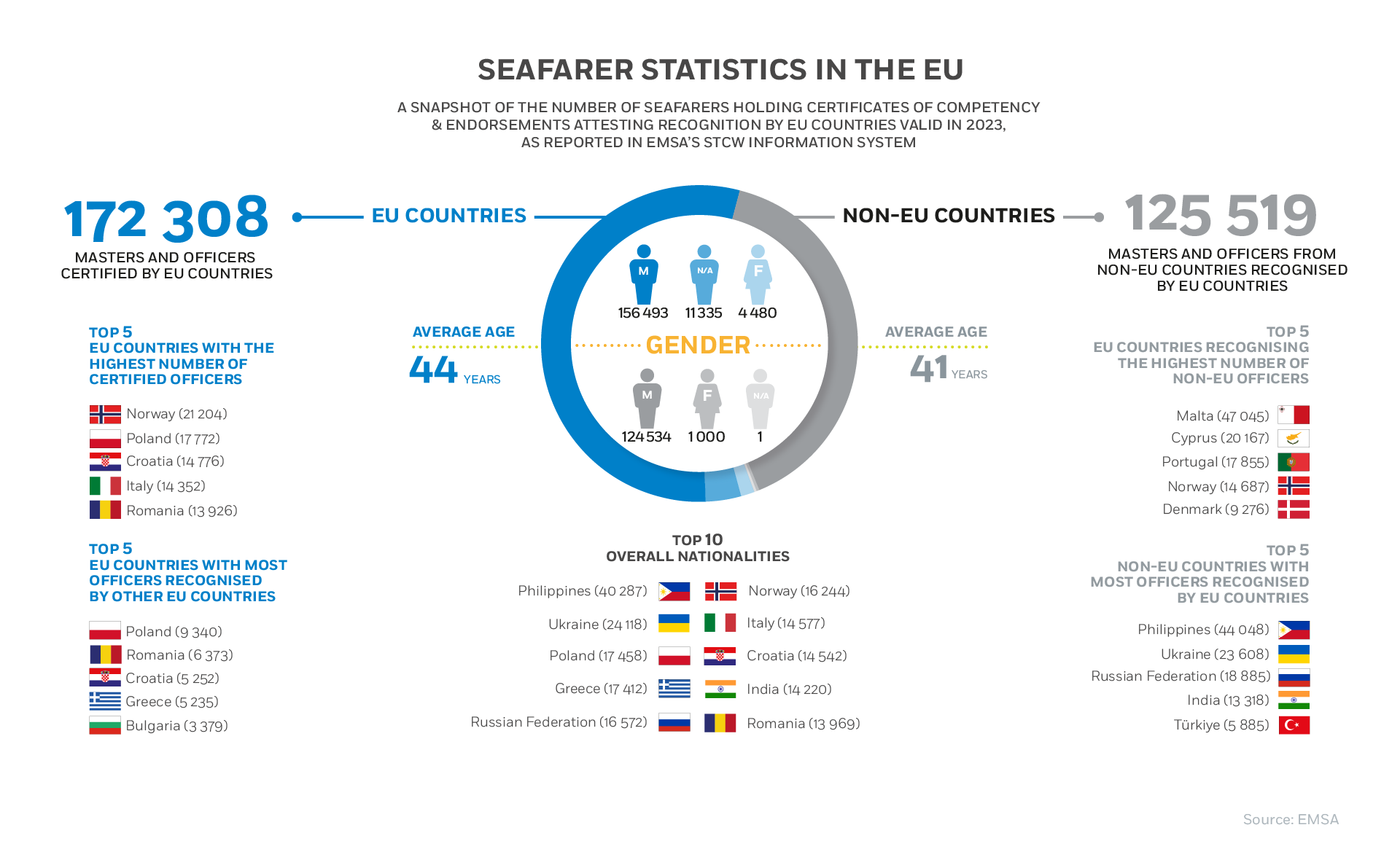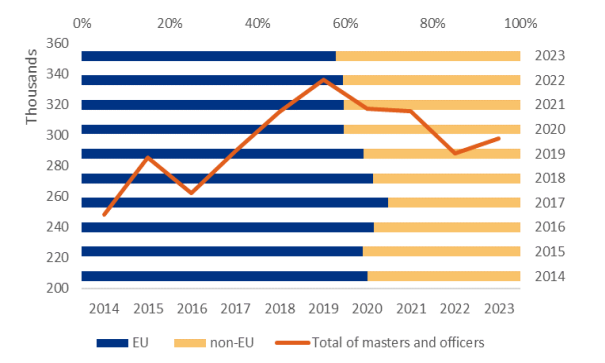You are here
EMSA: Seafarer Statistics in the EU 2023
EMSA: Seafarer Statistics in the EU 2023
The Editorial Team May 7, 2025 https://safety4sea.com/emsa-seafarer-statistics-in-the-eu-2023/
The European Maritime Safety Agency has released the Seafarer Statistics in the EU report, where it explores various statistics and trends regarding seafarers, during the year of 2023.
The statistical review presented in this report is based on data extracted from certificates and endorsements registered by EU Member States, Iceland and Norway until 31 December 2023. This data, which was transferred and recorded in the STCW Information System (STCW-IS) by 31 December 2024, represents a snapshot of the European labour market in terms of the number of seafarers holding valid certificates and endorsements in 2023.
Current certification statistics
The data included in the STCW-IS shows that by end-2023, 172,308 masters and officers held valid certificates of competency (CoC) issued by EU Member States1 while another 125,519 masters and officers held original CoCs issued by non-EU countries with endorsements issued by EU Member States attesting their recognition (EaR). Overall, the end of 2023 saw almost a third of a million masters and officers as potential manpower to serve on board EU Member State flagged vessels.
Top countries issuing certificates
The five EU Member States with the highest number of masters and officers holding CoCs issued by them in 2023 were, by order of magnitude, Norway, Poland, Croatia, Italy and Romania. The five EU Member States with most masters and officers holding EaRs issued by them, also by order of magnitude, were Malta, Cyprus, Portugal, Norway and Denmark. Finally, the five non-EU countries which had more masters and officers holding CoCs recognised by EU Member States were the Philippines, Ukraine, the Russian Federation, India and Türkiye.
Trends and stability
From the overview for the period 2014-2023, it can be observed that, between 2016 and 2019, the absolute number of masters and officers holding CoCs and EaRs and of ratings holding CoPs – and thereby of those available to serve on board EU Member State flagged vessels – increased. This trend was subsequently interrupted until 2022 influenced by Brexit and the COVID-19 pandemic. However, in 2023 a small increase can be observed. Nevertheless, the overall figures remained broadly stable in terms of distribution by country issuing the original CoC, by masters and officers by department, capacity, gender and age.
Labour market resilience
After ten years of the review exercise, it is possible to confirm a certain stability in the European maritime labour market. This stability suggests that the European labour market has been able to attract new entrants to replace those leaving the seafaring career. In 2023 and within the EU, the numbers indicate that over 5,000 officers got a CoC for the first time.
The review also indicates a stability in terms of age and the geographical region and countries from where seafarers originate. In terms of gender, the majority of female officers continues to be made up of those who hold CoCs issued by EU Member States entitling them to work in the deck department.
The percentage of female officers globally (EU and non-EU) is expected to continue increasing in the coming years. However, it remains unlikely that globally females will reach the 2% of the total number of masters and officers already available to serve on board EU Member State flagged vessel.
Distribution by department
The number of masters and officers holding valid CoCs in each department is presented in Figure 2-2. It illustrates that the number of masters and officers entitled to serve in the Deck Department (Chapter II of the STCW Convention) was 51% higher than the number of officers entitled to serve in the Engine Department (Chapter III of the STCW Convention). The officers grouped under ‘Alternative certification’ (Chapter VII of the STCW Convention) were reported as holding a multipurpose capacity.
Gender distribution
The information on gender was available for 160,973 masters and officers, representing 93.42% of the total number of officers at EU level holding a CoC.
Considering the total number of masters and officers whose gender was known, it can be stated with a level of confidence of 99% that the percentage of female masters and officers was 2.78% ± 0.08% compared to 97.22% ± 0.08% of male masters and officers.
Age distribution
The average age of masters and officers holding valid CoCs was 43.6 (years). Whereas the under-25 age group counted 5,641 masters and officers, all other age groups had a relatively uniform distribution, each counting between 16,021 and 26,624 masters and officers, which represented 9% to 14% of the total number.
source: https://www.philstar.com/the-freeman/opinion/2022/11/05/2221764/editoria...>

